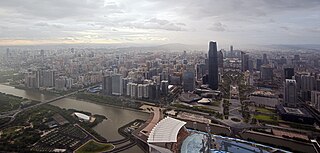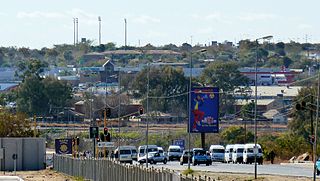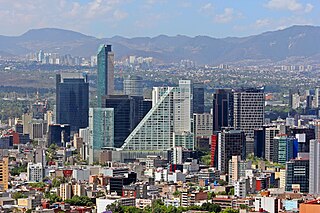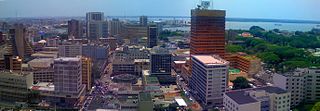
A city is a human settlement of a notable size. The term "city" has different meanings around the world and in some places the settlement can be very small. Even where the term is limited to larger settlements, there is no universally agreed definition of the lower boundary for their size. In a more narrow sense, a city can be defined as a permanent and densely settled place with administratively defined boundaries whose members work primarily on non-agricultural tasks. Cities generally have extensive systems for housing, transportation, sanitation, utilities, land use, production of goods, and communication. Their density facilitates interaction between people, government organizations, and businesses, sometimes benefiting different parties in the process, such as improving the efficiency of goods and service distribution.

A megacity is a very large city, typically with a population of more than 10 million people. The United Nations Department of Economic and Social Affairs in its 2018 "World Urbanization Prospects" report defines megacities as urban agglomerations with over 10 million inhabitants. A University of Bonn report holds that they are "usually defined as metropolitan areas with a total population of 10 million or more people". Elsewhere in other sources, from five to eight million is considered the minimum threshold, alongside a population density of at least 2,000 per square kilometre. The terms conurbation, metropolis, and metroplex are also applied to the latter.

Urbanization is the population shift from rural to urban areas, the corresponding decrease in the proportion of people living in rural areas, and the ways in which societies adapt to this change. It can also mean population growth in urban areas instead of rural ones. It is predominantly the process by which towns and cities are formed and become larger as more people begin living and working in central areas.

A slum is a highly populated urban residential area consisting of densely packed housing units of weak build quality and often associated with poverty. The infrastructure in slums is often deteriorated or incomplete, and they are primarily inhabited by impoverished people. Although slums are usually located in urban areas, in some countries they can be located in suburban areas where housing quality is low and living conditions are poor. While slums differ in size and other characteristics, most lack reliable sanitation services, supply of clean water, reliable electricity, law enforcement, and other basic services. Slum residences vary from shanty houses to professionally built dwellings which, because of poor-quality construction or lack of basic maintenance, have deteriorated.

Urban geography is the subdiscipline of geography that derives from a study of cities and urban processes. Urban geographers and urbanists examine various aspects of urban life and the built environment. Scholars, activists, and the public have participated in, studied, and critiqued flows of economic and natural resources, human and non-human bodies, patterns of development and infrastructure, political and institutional activities, governance, decay and renewal, and notions of socio-spatial inclusions, exclusions, and everyday life. Urban geography includes different other fields in geography such as the physical, social, and economic aspects of urban geography. The physical geography of urban environments is essential to understand why a town is placed in a specific area, and how the conditions in the environment play an important role with regards to whether or not the city successfully develops. Social geography examines societal and cultural values, diversity, and other conditions that relate to people in the cities. Economic geography is important to examine the economic and job flow within the urban population. These various aspects involved in studying urban geography are necessary to better understand the layout and planning involved in the development of urban environments worldwide.
The urbanization of most of Africa is moving fast forward, especially south of the Sahara. It is estimated that in 1900, about 89% of inhabitants lived from the primary occupations of farming, hunting & gathering, cattle nomadism, and fishing meaning that 11% or less were urban. At the start of the independence period in 1957, 14.7% of Africa's inhabitants were urban, in 2000 had it risen to 37.2% and it is expected to rise to 49.3% in 2015, in effect 3.76% to 3.35% per year. In sub-Saharan Africa in 1960 "only one city, Johannesburg, had a population of one million;...in 2009, there were fifty-two cities with such large populations." The Nigerian city of Lagos that in 1963 had 665,000 inhabitants and 8.7 million in 2000 is expected to become the world's 11th biggest city by 2015 with 16 million inhabitants.

Hammanskraal is a trans-provincial region anchored in northern Gauteng province, South Africa. The region consists of multiple, residential, industrial and commercial areas in a decentralized settlement pattern.
Slum upgrading is an integrated approach that aims to turn around downward trends in an area. These downward trends can be legal, physical (infrastructure), social or economic." The main objective of slum upgrading is to rehabilitate them into functional neighborhoods by addressing the social needs of the community, and improving integration into the formal urban economy.

Urbanization in China increased in speed following the initiation of the reform and opening policy. By the end of 2023, China had an urbanization rate of 66.2% and is expected to reach 75-80% by 2035.
Shiba Prasad Chatterjee was a Professor of Geography at the University of Calcutta, India. He served as President of the International Geographical Union from 1964 until 1968, Chatterjee received a Murchison Award from the Royal Geographical Society in 1959, and a Padma Bhushan from the Government of India in 1985. He coined the name 'Meghalaya' for one of India's states.
Overurbanization is a thesis originally developed by scholars of demography, geography, ecology, economics, political science, and sociology in thrergence of International Nongovernmental Organizations Amid Declining States. The term is intentionally comparative and has been used to differentiate between developed and developing countries. Several causes have been suggested, but the most common is rural-push and urban-pull factors in addition to population growth.

Urbanization in India began to accelerate after independence, due to the country's adoption of a mixed economy, which gave rise to the development of the private sector. The population residing in urban areas in India, according to the 1901 census, was 11.4%, increasing to 28.53% by the 2001 census, and is now currently 34% in 2017 according to the World Bank. According to a survey by the United Nations, in 2030 40.76% of country's population is expected to reside in urban areas. As per the World Bank, India, along with China, Indonesia, Nigeria, and the United States, will lead the world's urban population surge by 2050.
Urbanization in Pakistan has increased since the time of independence and has several different causes. The majority of southern Pakistan's population lives along the Indus River. Karachi is its most populous city. In the northern half of the country, most of the population lives in an arc formed by the cities of Lahore, Faisalabad, Rawalpindi, Islamabad, Gujranwala, Sialkot, Gujrat, Jhelum, Sargodha, Sheikhupura, Nowshera, Mardan and Peshawar. During 1990–2008, city dwellers made up 36% of Pakistan's population, making it the most urbanised nation in South Asia. Furthermore, 50% of Pakistanis live in towns of 5,000 people or more.

Cities Alliance is a global partnership fighting urban poverty and supporting cities to deliver sustainable development. To manage its activities, the Cities Alliance operates a multi-donor fund with UN Office for Project Services (UNOPS), as host and trustee. Different members provide direction, financing and advocacy. Cities Alliance aims to deliver solutions to urban poverty.

Although the Democratic Republic of the Congo (DRC) has Africa's largest freshwater resources, it is suffering from an acute drinking water supply crisis. The DRC has one of the lowest rates of access to clean drinking water in Sub-Saharan Africa and the world. Only 46 percent of the population had access to an improved drinking water source in 2012. Furthermore, the sanitation coverage was estimated at only 31 percent in 2012. Up to date and accurate information on water supply and sanitation services in the DRC is scarce. As a result of inadequate water supply and sanitation services, many inhabitants are suffering from waterborne diseases, including diarrhoea, typhoid, and cholera.

Urban rail transit in Africa has emerged as a growing form of transit due to rapid urbanization that has occurred in recent decades across the continent. Some of these transit systems are older and more developed, such as the metro in Cairo which opened in 1987. Others such as the light-rail system in Addis Ababa are much more recent, which opened in 2015. A variety of technologies are being used ranging from light-rail, bus rapid-transit, and commuter-rail etc. Africa for several decades saw minimal investment in rail infrastructure, but in recent years due to urban population growth and improved financing options, investment in rail networks has increased.

Mexico City has massively been expanding its urban fabric and population density, becoming the fifth largest city in the world. A combination of neoliberal policies, complex geographic location, socio-economic disparities and inefficient strategies have influenced the process of gentrification in the city. The combination of numerous megaprojects and inefficient city-planning strategies have led to dysfunctions in circulation, community allocation and equal access to resources. In consequence, middle and low-income communities have been directly or indirectly alienated and challenged to adapt to a complex and evolving urban environment.

Climate change and cities are deeply connected. Cities are one of the greatest contributors and likely best opportunities for addressing climate change. Cities are also one of the most vulnerable parts of the human society to the effects of climate change, and likely one of the most important solutions for reducing the environmental impact of humans. The UN projects that 68% of the world population will live in urban areas by 2050. In the year 2016, 31 mega-cities reported having at least 10 million in their population, 8 of which surpassed 20 million people. However, secondary cities - small to medium size cities are rapidly increasing in number and are some of the fastest growing urbanizing areas in the world further contributing to climate change impacts. Cities have a significant influence on construction and transportation—two of the key contributors to global warming emissions. Moreover, because of processes that create climate conflict and climate refugees, city areas are expected to grow during the next several decades, stressing infrastructure and concentrating more impoverished peoples in cities.

The Abidjan–Lagos Corridor, also known as the Abidjan–Lagos Megalopolis, is an emerging transnational megalopolis on the coast of southern West Africa. It stretches from Abidjan to Lagos, crossing five independent states from west to east, and includes two political capitals and many regional economic centers. The corridor has a length of approximately 965 kilometers. Within the megalopolis, a significant portion of West Africa's economic output is generated, and cities within the corridor are among the most economically developed of their respective countries, for which agglomeration effects and access to the Atlantic Ocean are responsible. The population within the region is experiencing rapid growth, and nearly 50 million people are expected to live within the corridor by 2035. According to projections, by the end of the 21st century, the region could become the largest urban region with continuous settlement in the world, then with up to half a billion inhabitants.
Water stress is increasingly affecting urbanization. Water stress arises through slum development, anarchic construction, water scarcity, the absence of financial structures, the absence of basic structures, the absence of infrastructure such as roads, bridges, sidewalks, signs, markets, schools, etc., can sometimes hinder the productivity of certain cities. Unfortunately, this phenomenon affects even the largest cities in the world; in 2018, 300,000 were recorded in the world, housing around 40% of the world's urban population.















